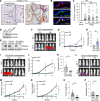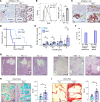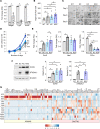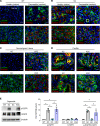ST6GAL1 sialyltransferase promotes acinar to ductal metaplasia and pancreatic cancer progression
- PMID: 37643018
- PMCID: PMC10619436
- DOI: 10.1172/jci.insight.161563
ST6GAL1 sialyltransferase promotes acinar to ductal metaplasia and pancreatic cancer progression
Abstract
The role of aberrant glycosylation in pancreatic ductal adenocarcinoma (PDAC) remains an under-investigated area of research. In this study, we determined that ST6 β-galactoside α2,6 sialyltransferase 1 (ST6GAL1), which adds α2,6-linked sialic acids to N-glycosylated proteins, was upregulated in patients with early-stage PDAC and was further increased in advanced disease. A tumor-promoting function for ST6GAL1 was elucidated using tumor xenograft experiments with human PDAC cells. Additionally, we developed a genetically engineered mouse (GEM) model with transgenic expression of ST6GAL1 in the pancreas and found that mice with dual expression of ST6GAL1 and oncogenic KRASG12D had greatly accelerated PDAC progression compared with mice expressing KRASG12D alone. As ST6GAL1 imparts progenitor-like characteristics, we interrogated ST6GAL1's role in acinar to ductal metaplasia (ADM), a process that fosters neoplasia by reprogramming acinar cells into ductal, progenitor-like cells. We verified ST6GAL1 promotes ADM using multiple models including the 266-6 cell line, GEM-derived organoids and tissues, and an in vivo model of inflammation-induced ADM. EGFR is a key driver of ADM and is known to be activated by ST6GAL1-mediated sialylation. Importantly, EGFR activation was dramatically increased in acinar cells and organoids from mice with transgenic ST6GAL1 expression. These collective results highlight a glycosylation-dependent mechanism involved in early stages of pancreatic neoplasia.
Keywords: Cancer; Glycobiology; Oncogenes; Oncology.
Figures








Similar articles
-
The pro-inflammatory cytokines IL-1β and IL-6 promote upregulation of the ST6GAL1 sialyltransferase in pancreatic cancer cells.J Biol Chem. 2024 Oct;300(10):107752. doi: 10.1016/j.jbc.2024.107752. Epub 2024 Sep 12. J Biol Chem. 2024. PMID: 39260693 Free PMC article.
-
Elevation of β-galactoside α2,6-sialyltransferase 1 in a fructoseresponsive manner promotes pancreatic cancer metastasis.Oncotarget. 2017 Jan 31;8(5):7691-7709. doi: 10.18632/oncotarget.13845. Oncotarget. 2017. PMID: 28032597 Free PMC article.
-
ANGPTL4 accelerates KRASG12D-Induced acinar to ductal metaplasia and pancreatic carcinogenesis.Cancer Lett. 2021 Oct 28;519:185-198. doi: 10.1016/j.canlet.2021.07.036. Epub 2021 Jul 24. Cancer Lett. 2021. PMID: 34311032
-
Acinar-to-Ductal Metaplasia (ADM): On the Road to Pancreatic Intraepithelial Neoplasia (PanIN) and Pancreatic Cancer.Int J Mol Sci. 2023 Jun 9;24(12):9946. doi: 10.3390/ijms24129946. Int J Mol Sci. 2023. PMID: 37373094 Free PMC article. Review.
-
Acinar cell plasticity and development of pancreatic ductal adenocarcinoma.Nat Rev Gastroenterol Hepatol. 2017 May;14(5):296-304. doi: 10.1038/nrgastro.2017.12. Epub 2017 Mar 8. Nat Rev Gastroenterol Hepatol. 2017. PMID: 28270694 Free PMC article. Review.
Cited by
-
Sialyltransferase-related genes as predictive factors for therapeutic response and prognosis in cervical cancer.PeerJ. 2025 May 22;13:e19422. doi: 10.7717/peerj.19422. eCollection 2025. PeerJ. 2025. PMID: 40416607 Free PMC article.
-
A lectin produced by a Streptomyces species targets mammalian pancreatic acinar cells in mice and humans.Sci Rep. 2025 Jan 22;15(1):2782. doi: 10.1038/s41598-024-80889-y. Sci Rep. 2025. PMID: 39843458 Free PMC article.
-
Sialylation of EGFR by ST6GAL1 induces receptor activation and modulates trafficking dynamics.bioRxiv [Preprint]. 2023 Jun 4:2023.06.03.543566. doi: 10.1101/2023.06.03.543566. bioRxiv. 2023. Update in: J Biol Chem. 2023 Oct;299(10):105217. doi: 10.1016/j.jbc.2023.105217. PMID: 37398202 Free PMC article. Updated. Preprint.
-
Sialylation-associated long non-coding RNA signature predicts the prognosis, tumor microenvironment, and immunotherapy and chemotherapy options in uterine corpus endometrial carcinoma.Cancer Cell Int. 2024 Sep 11;24(1):314. doi: 10.1186/s12935-024-03486-z. Cancer Cell Int. 2024. PMID: 39261877 Free PMC article.
-
Unraveling the glyco-immunity nexus in pancreatic cancer.Mol Cancer. 2025 Aug 4;24(1):211. doi: 10.1186/s12943-025-02417-4. Mol Cancer. 2025. PMID: 40759948 Free PMC article. Review.
References
Publication types
MeSH terms
Substances
Grants and funding
LinkOut - more resources
Full Text Sources
Medical
Molecular Biology Databases
Research Materials
Miscellaneous

